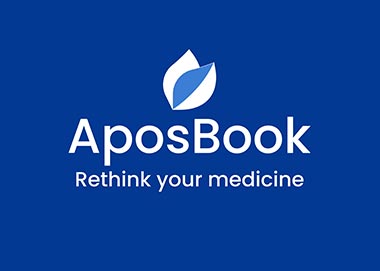Ready to leave?
Oops ! Condition name you have entered is invalid.
You are now leaving Aposbook.com and going to an external site managed by another organization.
Please confirm your email address and try to login again.
This account has been deleted. do you want to restore it?

Validate your email
A verification link will be sent to within the next 2 minutes. Please click it to validate your e mail.
*If you didn't get the link, please check your spam folder
Welcome to Aposbook,
As a registered user, you can benefit from the various free tools and services that we provide.
All you need to do is log in to start discussing with others, interacting, asking questions, and sharing your point of view about the various topics.
You can also write reviews and testimonials about any natural solution you have tried and share your experience. Your feedback can be very helpful.
If you are a health expert, you can add information about any topic or suggest text edit. You can also publish content, including articles and videos, about any topic from the related library section.
Together we can help.
The Aposbook Team
Forgot Password?
A validation link will be sent to you by email. Please confirm your address to log in
*If you didn't get the link, please check your spam folder
Please log in to use this feature
Your account has been suspended because you have violated our code of conduct. If you think this was a mistake, you can contact us by email at: support@aposbook.com "Contact us" form.
Success! Thank you for your feedback. Your contribution can make a difference. Together we can help each other.


Can Low Glycemic Index Diet Treat Acne?
Complete Guide to Low Glycemic Index (LGI) Diet For Acne
Understanding Acne causes from the Low Glycemic Index Diet perspective
Acne is a common skin condition among all people, but it affects primarily teenagers going through hormonal changes. It is mainly characterized by pimples and other abnormalities on the face and upper torso and appears as a result of increased production of sebum from the sebaceous glands.
This excess oil leaves the skin’s pores clogged and increases the proliferation of bacteria, resulting in comedones, which have the popular name of ...
Understanding Acne causes from the Low Glycemic Index Diet perspective
Acne is a common skin condition among all people, but it affects primarily teenagers going through hormonal changes. It is mainly characterized by pimples and other abnormalities on the face and upper torso and appears as a result of increased production of sebum from the sebaceous glands.
This excess oil leaves the skin’s pores clogged and increases the proliferation of bacteria, resulting in comedones, which have the popular name of clove.
Visit our "Library Center" section below to find all the information on the possible causes of acne that might be managed by the Low Glycemic index Diet.
Learn everything about acne and find all the natural solutions to treat it naturally, including various diet programs, alternative medicine, vitamins, supplements, herbal medicine, and home remedies.
Why Low Glycemic Index (LGI) Diet helps Reduce Acne
Scroll down to check all the resources we have on this topic in the “Library Center”.
Meanwhile, we are working on this section's content, and we will publish it soon. If you are an expert on this topic, please suggest related information.
Together we work to help the community.
Why Low Glycemic Index (LGI) Diet helps Reduce Acne
Scroll down to check all the resources we have on this topic in the “Library Center”.
Meanwhile, we are working on this section's content, and we will publish it soon. If you are an expert on this topic, please suggest related information.
Together we work to help the community.
How Low Glycemic Index (LGI) Diet works for Acne
Scroll down to check all the resources we have on this topic in the “Library Center”.
Meanwhile, we are working on this section's content, and we will publish it soon. If you are an expert on this topic, please suggest related information.
Together we work to help the community.
How Low Glycemic Index (LGI) Diet works for Acne
Scroll down to check all the resources we have on this topic in the “Library Center”.
Meanwhile, we are working on this section's content, and we will publish it soon. If you are an expert on this topic, please suggest related information.
Together we work to help the community.
Low Glycemic Index (LGI) Diet for Acne: Food List
Scroll down to check all the resources we have on this topic in the “Library Center”.
Meanwhile, we are working on this section's content, and we will publish it soon. If you are an expert on this topic, please suggest related information.
Together we work to help the community.
Low Glycemic Index (LGI) Diet for Acne: Food List
Scroll down to check all the resources we have on this topic in the “Library Center”.
Meanwhile, we are working on this section's content, and we will publish it soon. If you are an expert on this topic, please suggest related information.
Together we work to help the community.
Low Glycemic Index (LGI) Diet for Acne: Diet Program
Scroll down to check all the resources we have on this topic in the “Library Center”.
Meanwhile, we are working on this section's content, and we will publish it soon. If you are an expert on this topic, please suggest related information.
Together we work to help the community.
Low Glycemic Index (LGI) Diet for Acne: Diet Program
Scroll down to check all the resources we have on this topic in the “Library Center”.
Meanwhile, we are working on this section's content, and we will publish it soon. If you are an expert on this topic, please suggest related information.
Together we work to help the community.
Low Glycemic Index (LGI) Diet for Acne: recommendations
Scroll down to check all the resources we have on this topic in the “Library Center”.
Meanwhile, we are working on this section's content, and we will publish it soon. If you are an expert on this topic, please suggest related information.
Together we work to help the community.
Low Glycemic Index (LGI) Diet for Acne: Things to Avoid
Scroll down to check all the resources we have on this topic ...
Low Glycemic Index (LGI) Diet for Acne: recommendations
Scroll down to check all the resources we have on this topic in the “Library Center”.
Meanwhile, we are working on this section's content, and we will publish it soon. If you are an expert on this topic, please suggest related information.
Together we work to help the community.
Low Glycemic Index (LGI) Diet for Acne: Things to Avoid
Scroll down to check all the resources we have on this topic in the “Library Center”.
Meanwhile, we are working on this section's content, and we will publish it soon. If you are an expert on this topic, please suggest related information.
Together we work to help the community.
Low Glycemic Index (LGI) Diet for Acne: precautions
Scroll down to check all the resources we have on this topic in the “Library Center”.
Meanwhile, we are working on this section's content, and we will publish it soon. If you are an expert on this topic, please suggest related information.
Together we work to help the community.
Low Glycemic Index (LGI) Diet for Acne: precautions
Scroll down to check all the resources we have on this topic in the “Library Center”.
Meanwhile, we are working on this section's content, and we will publish it soon. If you are an expert on this topic, please suggest related information.
Together we work to help the community.
Low Glycemic Index (LGI) Diet for Acne: side effects
Scroll down to check all the resources we have on this topic in the “Library Center”.
Meanwhile, we are working on this section's content, and we will publish it soon. If you are an expert on this topic, please suggest related information.
Together we work to help the community.
Low Glycemic Index (LGI) Diet for Acne: side effects
Scroll down to check all the resources we have on this topic in the “Library Center”.
Meanwhile, we are working on this section's content, and we will publish it soon. If you are an expert on this topic, please suggest related information.
Together we work to help the community.
Reviews & Testimonials
-
Overall rating
-
Success Rate
-
Effectiveness
-
Accessiblity
-
Safety
-
Fast result
-
Ease of use
Add review
Was solution successfull?
Overall rating score
Rate each parameters
Effective
Accessible
Safe
Fast results
Easy to apply
Review title
Add images to support your review(if any)
Support images
You can review a solution if you have used it personally. Please remain objective and genuine. Your input can help others.
You have already reviewed this
Please rate all parameters.
Success! Thank you for your feedback. Your contribution can make a difference. Together we can help each other.
What science says about Low Glycemic Index (Lgi) Diet For Acne
Library center Low Glycemic Index (LGI) Diet For Acne
Additional benefits of Low Glycemic Index (LGI) Diet

















[0]